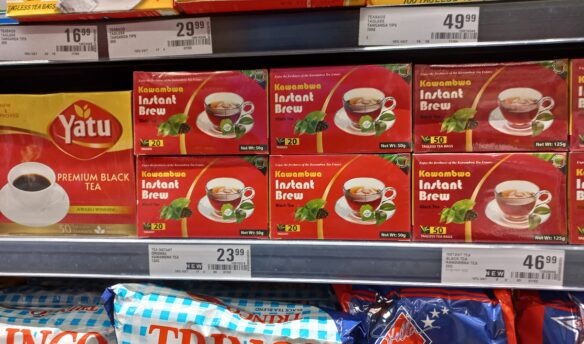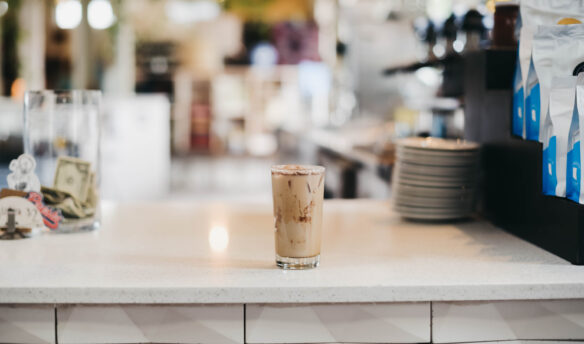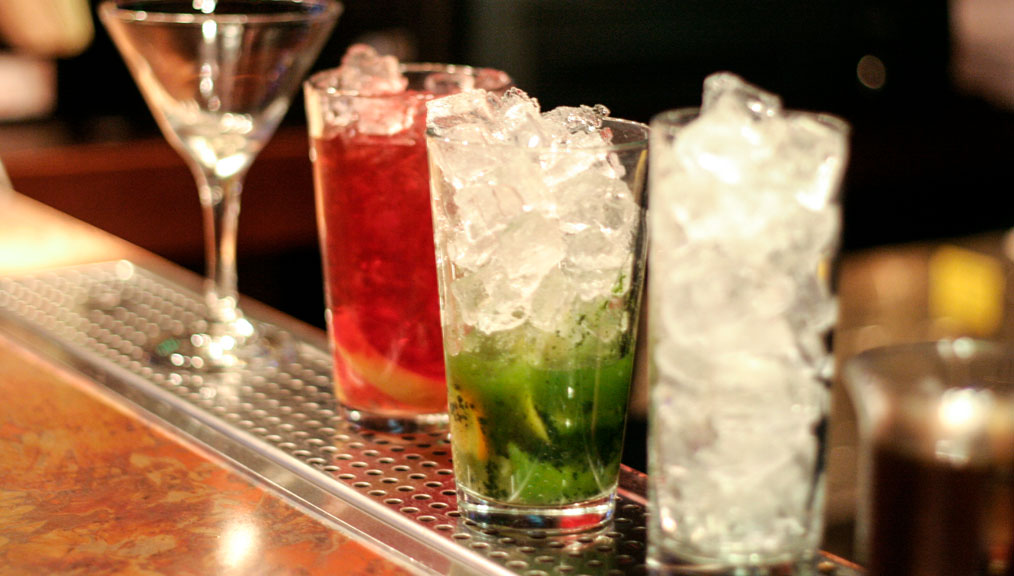[O]ne of my most treasured family heirlooms is a rectangular tin, faded from sitting on sunny shelves for over three generations. It faintly reveals the phrase tea bags and notes the quantity inside. Fast-forward to the present day, to a specialty tea industry teeming with devoted fans who thirst for knowledge beyond the basic identifier, “tea.” With this evolution towards knowledge comes a need for tea brands—and tins—to rise above the average and create a connection with the consumer by pleasing their eye, mind, and palate. Tea leaves carry the weight of a novel within their vibrant veins and are only truly enjoyed when their story is told. Tea companies must now excite our eyes with modern aesthetic and entice our minds with storytelling that weaves together culture, science, terroir, and design. The challenge is to convey all of this in a way that is easy to digest as one sips his or her way through a cup of tea.
Packaging sets the tone for an emotional connection with the leaves hidden within the tin, box, or pouch. For the novice tea enthusiast, packaging serves as a guide to a new world. For the connoisseur, it’s a companion presenting a challenge: to see if what’s inside meets the standards and story presented.
We are always subconsciously deciding whether the aesthetic of tea packaging excites us and resonates with our values, and if we believe the brand is being authentic and transparent with the stories it shares. Before we open a sealed bag or foil pouch, we carefully read the flavor descriptions to see if they perk our interest. The design of the packaging is what draws us in, and, after the first steep, the information it shares combines with our sensory judgment to help us make a connection with the brand, and decide whether we will steep again.
Tea companies must now excite our eyes with modern aesthetic and entice our minds with storytelling that weaves together culture, science, terroir, and design.
For me, three brands—Dachi Tea Company, Tea Ave, and Sense Asia—elevate the tea experience by going beyond the expected with their packaging style. The experiences they create with meticulously designed boxes and pouches are also expertly mirrored on each company’s website. Farmers, flavors, and patches of land are the draw, bringing purists and novice drinkers alike into a richer tea experience, while sparking continued interest in the origin of leaves, the science of brewing, and the human stories behind each cup.
[T]aipei-based Dachi Tea Company, a brand that specializes in Taiwanese oolong, was co-founded by Nicholas Palumbo and Simon Thomas. Before the owners launched their Kickstarter in November 2014, Simon and Nick spent many months in the mountains, studying with Taiwanese tea makers. They first captured my attention with a modern-yet-nostalgic aesthetic; Dachi’s packaging is reminiscent of a chocolate bar. It elicits an emotional response of a coveted chocolate treat to be slowly savored. Palumbo notes that the shape of the packaging is practical, due to ease of shipment, but also says that “tea is to us now what chocolate was to us as children: we wanted to recreate the subliminal nostalgia that comes with holding something delicate and special.”
As someone who welcomes getting lost in flavor descriptors, I was pleased to see tasting notes offered in full sentences, with a trio of descriptive flavor notes, and memorable illustrations. For Dachi’s Alishan sky high oolong, “a magnolia bouquet aroma precedes notes of natural spring water and the lasting sweetness of sugar.” There are also the flavor notes: “magnolia, sugarcane, spring water,” each with an icon illustration of the flavor (which was inspired by perfume advertisements that built a sensual description to entice the customer without tangibly experiencing the product).
When I ask for the thought process behind this style of expression, Nicholas says the graphics help grab the attention of drinkers unfamiliar with the tea type. “The terms full-bodied, tannic, and balanced speak directly to the connoisseur, but those who are new to tasting intently relate taste to flavor,” he says. “This is why we wanted to put the three predominant notes at front and center. We chose to add the icons because visual images are far more effective at talking to the taste buds than words.” As my first sip of Alishan oolong lingered on my taste buds, I was searching for a word to capture the pure taste and was delighted to see “spring water” on the label to help define my experience. This strategic approach to storytelling conveys a dedication to enticing and educating the tea enthusiast.
The tea seemed to carry greater weight as I neared the end of the farmer’s story; the flavors more pronounced as I connected with the notion that generations of a family had nurtured the tea plant.
Not allowing any space to go to waste, Dachi uses one side panel of their wrapper to reveal the harvest date, while the second illustrates a brew guide (again with icons). And then, as if they were effortlessly directing your experience post-steep (with the guide) and at first sip (with the flavor descriptions), you turn the package to reveal a back panel that invites you to “meet the maker,” the tea grower, represented by a photograph, story, and quote.
“What elevates a tea from the commonplace to the sublime is the intricate understanding of the surrounding environment by the (tea maker),” says Nicholas. “It’s a veritable art form—the coming together of tradition and terroir. There is a human element in the making of a nuanced, small-batch tea which means that it cannot be mass-produced and commoditized, and putting the face and a representation of the maker’s personality is our way of paying homage to this.”

The tea seemed to carry greater weight as I neared the end of the farmer’s story; the flavors more pronounced as I connected with the notion that generations of a family had nurtured the tea plant. While savoring the last few sips, I browsed the elevation level, oxidation, and roast. Notes on caffeine, antioxidants, and theanine I reserved for exploration while I waited for the water to heat for a second steeping. Feeling refreshed from a sensory escape, it was then that I understood what Thomas meant when he said, “We want our teas to feel like souvenirs from the vacations you are yet to take.”
[T]ea Ave, also dedicated to sharing the experience of Taiwanese oolongs, immediately captivates with the bright-yet-soothing turquoise color that is the dominant hue throughout their packaging. Prior to launching their website in March, Tea Ave co-founders Heidi and Jeff Chen sought design inspiration far from their Vancouver home with a design agency based in Spain. The collaborative effort between Tatabi Studio and Tea Ave’s in-house designer pushed the company’s packaging to its very best from multiple perspectives.

The packaging’s aesthetic, both elegant and simple, communicates the beautiful characters of their teas before they’ve even been steeped. Their commitment to detail is best expressed by the fact that they spent close to one month seeking a print shop who had the exact Pantone gold color they desired. The muted gold text, with just a hint of sheen, was very important to the expertly curated labels.
Heidi and Jeff followed a formula when creating each tea description, including three points: a high-level view of what the tea is; the feeling they perceived when drinking the tea; and the notes that they picked up, from start to finish. Their oriental beauty tea was “processed entirely by hand” and is “a luxurious, highly specialized tea produced only once a year, during summer. The flavor is one of a kind, strong yet mellow, with subtle honeyed notes.”

While browsing the remainder of the label I imagined traveling to the tea’s origin, climbing mountains while reading about its altitude, and considering the process of oxidation and roasting. It was as if I was experiencing an incredibly abbreviated version of the life of a tea farmer in terms of how they craft these transcendental teas. Grounding myself in my kitchen (quite far from my imagined Taiwanese tea adventure), I was struck by the instructions for four styles of brewing: Western (tea bag and tea pot), Eastern (gaiwan), and cold-brewed. When asked why they chose to share four styles, Heidi and Jeff explained, “We have seen tea lovers shy away from Eastern brewing styles due to the overwhelming information on teaware, steps, and process. We want to avoid that and let the tea lovers know when you have a good tea in hand, you can brew it however you like it.”
[S]ense Asia’s tasting sets allow for a hyper-localized tasting experience. Their Vietnamese teas are new to mass market tea consumers. In order to offer the strongest representation of that nation, a collection of thirty-two hand-selected teas, the Sense Asia team—composed of professionals from Russia, the US, Vietnam, and Australia—tasted 346 teas from twenty-eight farms in seventeen towns and villages across Vietnam over the course of seventy-two days.

Within each curated set, there are vacuum-packed cubes of tea leaves wrapped in paper packaging featuring an image of a tea farmer or resident from that particular region. The choice to share photos of those who make the tea and those who enjoy them locally allows us to make a connection with a faraway community (larger sets contain books with descriptions and profiles of those featured on the tea cubes). An interior panel has the tea’s flavor profile, origin information, and steeping instructions. Large “Taste Vietnam” boxes contain all thirty-two teas that create a map of Vietnam when the boxes are aligned. The grand box also reveals a grid printed inside the lid that shares four teas in eight categories based on when to enjoy them.
Sense Asia is conveying the building blocks of the tea experience. Their sets emphasize the many individuals who represent a specific tea region, and connect the drinker to them as directly as possible through packaged leaves. As with Tea Ave and Dachi, the experience is transportive, informational, and imbues the drinker with a hunger for similar experiences with other teas.
The depth of information these companies bring to their packaging is no minor thing. Across all sorts of food categories it’s becoming more common, and tea drinkers, often conscientious food consumers as well, are increasingly demanding this level of insight. The bar is being amply raised for what a box or bag can say.
Becoming attuned to this new level of information and understanding can be an advantage to drinkers, retailers, wholesalers, and tea growers alike. Cafés and restaurants should consider offering descriptions of nuances, altitude, and maybe even trios of flavor illustrations on their menus, or with each steeping.
My hope is that many years from now I will have passed down my grandmother’s blue tea tin along with my own collection of deeply detailed stories that set that bar for the next generation of tea enthusiasts.
—Alexis Siemons is a regular contributor to Fresh Cup. She writes at Teaspoons and Petals.
















